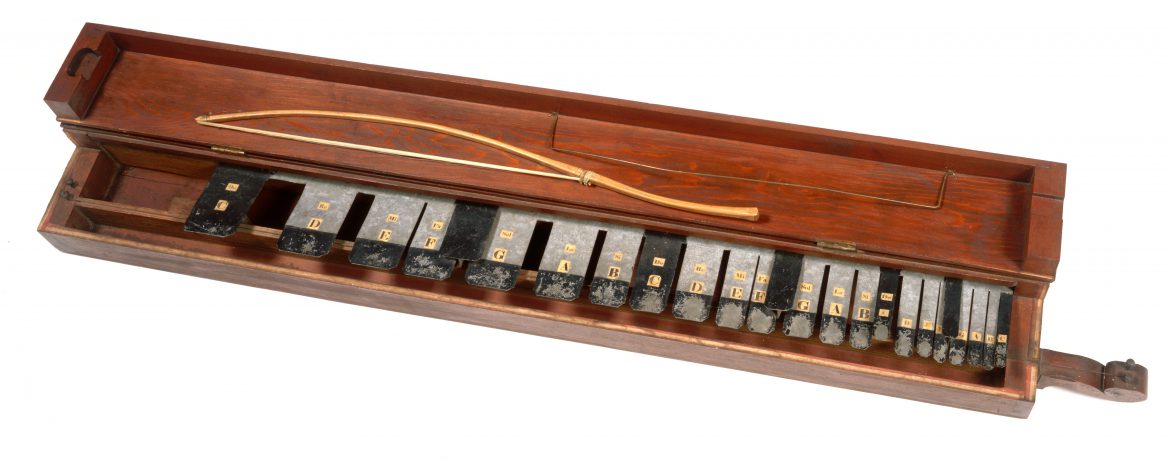
Piano-Violin, Church Family, Mount Lebanon, NY, ca. 1869, Shaker Museum | Mount Lebanon, 1961.12948.1
In the mid-1860s a local “Professor of Music” encouraged the singers at the Shaker Village at Canterbury, New Hampshire, to explore the study of music in order to improve the presentation of their traditional songs. The result was a change from the unique letteral notation the Shakers used for transcribing the melodies of songs to the more generally […]
In the mid-1860s a local “Professor of Music” encouraged the singers at the Shaker Village at Canterbury, New Hampshire, to explore the study of music in order to improve the presentation of their traditional songs. The result was a change from the unique letteral notation the Shakers used for transcribing the melodies of songs to the more generally used round-headed notes, the introduction of singing in parts rather than only in unison, and the eventual introduction of instrumental music by way of organ and piano. Some Shakers believed these and other changes were necessary in order to keep pace with the times and continue to attract converts.
In the midst of this transition, an inventive Shaker brother, Elisha D’Alembert Blakeman, struck out on a course that he thought would help attract new adherents through music. Brother Elisha was born in 1819 in Clyde, New York. His father, Elisha Sr., a medical doctor, became acquainted with the Shakers at Sodus Bay when they were in need of his medical expertise. When Elisha’s mother died in 1830, his father and Elisa Jr. both united with the Shakers. They eventually moved to Mount Lebanon, the senior Blakeman at the North Family and younger at the Church Family. At age 15, young Elisha began learning the trade of cabinetmaking. With an inventive, occasionally whimsical mind and a readiness to serve the community, Brother Elisha created and patented a fly-trap; designed “a self-regulating ventilator for lodging rooms &c – to be set under or over the sash of the windows – operated by the wind”; and, when the family’s water power failed, built a swing to which a churn was attached so “one, two or more, then get into the swing, [and] have the delicious pleasure of a swing, while the churn is bringing forth butter.” Late in the 1860s Brother Elisha, most likely very familiar with a “monochord” used by the family to set the pitch for their songs, set out to make an improvement in the instrument that would make it not only a useful tool but an instrument which could accompany singers.

Piano-Violin, Church Family, Mount Lebanon, NY, ca. 1869, Shaker Museum | Mount Lebanon, 1961.12948.1
The monochord that the Shakers used in setting the pitch for songs was developed by Brother Isaac Newton Youngs to regularize the performance and presentation of Shaker music from family to family and community to community. Brother Isaac’s monochord was a simple instrument consisting of a string stretched over a hollow box that would reverberate when placed on an empty chest or a table. The pitch of a given song could be set by holding a wooden block down on the string at a marked interval and striking the string to produce the sound. Brother Elisha improved this simple instrument by adding metal keys to replace the wooden block and substituted a violin bow for the pluck of a finger to give the instrument a sweeter sound.

U.S. Patent 114,520 for an Improvement in Piano-Violins by E. D. Blakeman, 1871, U. S. Patent Office.
In 1871 Brother Elisha sought and received a patent for his improved monochord under the name “Piano-Violin.” The patent was secured by Munn & Company, editors of Scientific American and patent agents. Brother Elisha continued to make improvements on his instrument to the point that on May 6, 1871 he gave a concert on his “new instruments, ‘Piano-Violins.’ The two built of chestnut wood in tune with each other, and my old big cherry, built two years since which carried double base—for the first trial of the three in harmony, the music was very fine.” Following the publication of the patent, Brother Elisha received inquiries from people who wanted to be agents to sell his new instrument. To promote its usefulness he gave demonstrations to school teachers to encourage its use as a teaching tool. Brother Elisha, convinced he could benefit the Church with his new instrument by giving concerts to attract new members, approached the Ministry for permission to do so. The Ministry did not support his offer. The allure of manufacturing and selling his piano-violin combined with his disappointment in not being able to use the instrument to further the Shaker Church, caused Brother Elisha to leave his Shaker home in March of 1872.
Whether Elisha Blakeman went on to manufacture his piano-violins has not been determined. He did live nearly three decades after leaving the Shakers, dying in Chillicothe, Ohio on April 11, 1900.
The Piano-Violin in the collection at Shaker Museum | Mount Lebanon is the only one known to have survived. It is, of course, possible that there are others in various collections of musical instruments that have not been connected with their Shaker origin. The Museum’s instrument can be traced to Sister Sadie Neale at Mount Lebanon.